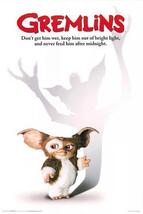|
Gremlins (1984) is a PG-rated comedy horror that runs one and three-quarter hours. The screenplay was written by Chris Columbus and directed by Joe Dante, who gave us The Goonies (1985) and Explorers (1985), respectively, the following year. It made over US$148 million at the American box office (keep in mind that this figure is in unadjusted dollars). It is set at Christmas in an enjoyable way, similarly to Home Alone (1990)—as opposed to Die Hard (1988) and The Lion in Winter (1968), which are also set at Christmas but lack a Christmassy feel. It tells the story of a teenager named Billy, played by Zach Galligan, who receives a unique, furry little creature for Christmas that multiplies and terrorizes his American town. If, like me, you’re a Gen-Xer, you’ll have fond memories of Gremlins. Depending on your age it may even be the first time Corey Feldman showed up on your radar. Back then he was as cute as Gizmo, the creature Billy’s father brings back from a business trip. Again, depending on your age you may have owned a Gizmo figurine or stuffed toy, as they were very popular. I had a figurine. There was quite a bit of merchandising. Perhaps not as much as for E.T. the Extra-Terrestrial—I haven’t looked into it—but it certainly wasn’t negligible. It likely made Steven Spielberg, Gremlins’ executive producer, quite a bit richer than he already was. One wonders what he does with all that money. My film commentaries aren’t full movie reviews. Typically I shine a spotlight on just one aspect of the movie, for example, language, the sexualization of the female characters or violence against women and girls. However, for Gremlins I’d like to discuss a few different aspects, all of them relating to the female characters, of course. One of the things that interests me most about movies is the way the female characters are treated. Since Gremlins is such an old movie I’m not worried about spoilers. If you are you should probably stop listening now. Let’s start with women’s presence and voice. There’s only one exchange between women, and it is hostile (Belinda Balaski, who plays a very small role, asks Polly Holliday a question and Holliday responds meanly). If it doesn’t bother you that a feature length film only includes one exchange between women you should ask yourself this: how many movies can you name in which there is only one exchange between men? There are three significant named female characters and they are played by Phoebe Cates, Frances Lee McCain and Polly Holliday. Cates plays Kate, the protagonist’s love interest. McCain plays his mother, and Holliday plays the staple unlikeable old lady, named Ruby Deagle. She’s mean, lives alone with a bunch of cats and says things like, “I hate Christmas carollers.” She’s a rude and manipulative client at the bank where Billy works as a teller. Twice she threatens to kill his dog, saying she would like to give him a “slow, painful death.” Holliday has no likeable traits, and we are meant to dislike her, as is often the case with old women in mainstream movies. She’s sort of a cross between the crazy old cat lady and the wicked witch. This isn’t the only mean old lady Chris Columbus has given us. The next year, in The Goonies, it was ‘Mama Fratelli’, played by Anne Ramsey. In Gremlins, as per the established cinematic formula, the mean old lady is punished in the end, killed off in this case. Moreover, the scene in which the old cat lady is killed is meant to be funny. That’s right: the filmmakers use violence against women as a comedic device—not for the first time in film and far from the last. Here’s what happens: the gremlins, which are the mischievous and repulsive creatures that the cute, furry creatures eventually turn into, tamper with the stairlift in Holliday’s house and she zips up her stairs, screaming, before being ejected out a window into the street below. Her chair then appears on the sidewalk, with her legs and feet in the air. And we’re meant to enjoy the way she’s been treated because she’s such a horrible person. Here’s something else worth noting: as she zips up the stairs she passes a framed picture of a smiling man looking in the direction she is heading. He seems happy to see her going that way. This reminds me of the sticky end the Wicked Witch of the West comes to in The Wizard of Oz (1939). In that case the horrible, unlikeable old woman, played by Margaret Hamilton, was totally obliterated and viewers were meant to rejoice, as the film’s other characters did. These are just two examples of old woman murders among the numerous ones cinematic history has provided. Filmmakers often portray old women as terrible, unlikeable people and then treat them very badly to punish them. Now that our societies have made it illegal to kill women for being ‘witches’ it seems male filmmakers are finding consolation in murdering them on the big screen. There isn’t much to say about Phoebe Cates, the love interest. Sexualization isn’t really an issue here. Cates and the other female characters are modestly dressed throughout. She even wears a dress that is buttoned up to her chin. And McCain wears slacks and a cardigan over her dress shirt. Compare this with the way women are dressed in A Bad Moms Christmas (2017). We’ve come a long way in thirty-some years—a long way in the wrong direction as far as costumes are concerned. I miss the modest, comfortable outfits actresses got to wear in the ‘80s. Something worth mentioning about Phoebe Cates concerns the flasher scene: a gremlin in a trench coat exposes himself to her in a bar, and this is supposed to be humorous. Remember: the filmmakers are men. This sort of thing often appears to be funny to men—not so much to women. This kind of inclusion trivializes sexual predators. When I was in my early twenties I found myself in a bar, at a table with some male friends and a man I didn’t know joined our party and made a joke of putting his penis on the table for me to look at. He seemed to think his joke was hilarious but twenty-some years later I still haven’t forgotten how inappropriate and unwanted this attention was. It would be great if filmmakers would stop trivializing sexual harassment. If they took it seriously I suspect men eventually would, too. Another thing worth discussing is the gender roles. They are very traditional. Cates serves male gremlins beer and Frances Lee McCain makes supper and gingerbread cookies and hangs up her husband’s coat for him when he comes home. For some reason he’s incapable of doing this for himself. McCain regularly played moms in the ‘80s, for example in Stand by Me and Back to the Future. Here again she is a stay-at-home mom, and she appears in the kitchen a few times. It’s as if the filmmakers were pining for the 1950s that existed in TV and Movieland. McCain’s family has a Leave it to Beaver feel to it. In the ‘80s my own mother was working a full-time job and taking university classes. She didn’t spend much time in the kitchen, and she was hardly unique in this way. In Canada workplaces were full of women and there weren’t too many June Cleavers to be seen in real life. In Gremlins women with lines play a bank clerk/waitress, housewives and a professionless woman. Men occupy the dominant positions: a police sheriff and a bank manager. Other men with lines play: a bank teller, an inventor, a store owner, a teacher and a policeman. Both Frances Lee McCain and Phoebe Cates, like Polly Holliday, are victims of violence. Gremlins throw dishes at McCain and try to choke her and a gremlin shoots at Cates. McCain, a middle-aged woman, fares better than Holliday though. She gets to defend herself and kill the gremlins wrecking her kitchen. For once I didn’t mind filmmakers showing a woman using her blender and microwave. I also liked how she armed herself with a few knives, not just one. Unfortunately, she ends up having to be saved by her son. A female filmmaker, I believe, would have shown her ridding her house of gremlins on her own without the help of her teenage son. That would have been more progressive anyway. And it’s not as if women hadn’t successfully battled monsters in film at that point. Look at what Sigourney Weaver did in Alien (1979) five years earlier. Additionally, in an opening scene of Gremlins a random boy smashes a snowball over a girl’s head. This behaviour is meant to appear normal. What it actually does is normalize this type of behaviour. Gremlins gives us a grim Christmas but it’s amusing and well made and as far as horror movies go female viewers could do much worse. My upcoming film guide for women contains 500 feature film reviews. I look forward to sharing my findings about mainstream movies of the 20th and 21st centuries and what they have to offer female viewers. It had been my intention to make this article funnier, as a way of honouring Magdalen Berns, who died of cancer one year ago today. Magdalen taught me a great deal about one issue in particular and introduced me to at least one amazing woman, for which I am very grateful. I highly recommend checking out her YouTube channel. She and her witty commentaries are greatly missed by many women I know. Copyright © 2020 Alline Cormier
0 Comments
Leave a Reply. |
Categories |


 RSS Feed
RSS Feed